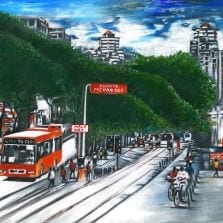A collaborative initiative between the public and private sector is set to advance integrated urban development in Africa.
Aurecon, in partnership with PricewaterhouseCoopers (PwC) and the South African Local Government Association (SALGA) officially launched the Our African City dialogue at the Institute of Municipal Engineering of Southern Africa (IMESA) conference in Cape Town on 28th October 2015. Lulu Gwagwa, Chair of Aurecon RSA Board says that in pursuit of being future ready company with its partners commit to being at the forefront of shaping Africa’s destiny through transformation, innovation and advancing the African agenda. According to Abbas Jamie Aurecon’s Market Director for Government and Transport, Our African Cities is a dialogue on inclusive transformation that intends to craft a vision of what future African cities should look like. “We believe that the private sector needs to partner with and support local government in its role of developing world class African Cities. We have thus initiated this dialogue with the intention of aligning the private sector with the Integrated Urban Development Framework (IUDF) document that will shortly be released by the Department of Cooperative Government and Traditional Affairs (COGTA).” Dr Gwen Ramokgopa, Aurecon’s ambassador for the Our African City initiative delivered the keynote address on the OAC dialogue at the IMESA event. Ramokgopa, who was the former Deputy Minister of Health and Mayor of the City of Tshwane, says that the company invites all stakeholders to become part of the Our African Cities initiative. “It is a dialogue that is initiated, developed and owned by Africa with the intention of fostering a shared understanding across government and society about how best to manage urbanisation. Through this dialogue we can make a significant contribution to achieving the goals of economic development, job creation and improved living conditions for all of our people and transforming our cities.” “Globally, there’s a great deal of innovation surrounding futuristic city planning. While many of these concepts, technologies and ideas are novel and relevant, they aren’t always implemented appropriately in Africa. It’s time that Africa takes ownership for developing, planning and creating the cities that meet the needs of Africans today and in the future,” says Jamie. Africa’s cities continue to grow at an unprecedented rate and the United Nations (UN) has estimated that the nearly 80% urbanisation rate expected by 2050 will see 1.26 billion people living in African cities – more than the entire population of the continent today. Unfortunately, urbanisation in our cities continues to lead to informal settlements and unplanned urban sprawl. Historic segregation in countries like South Africa has become more difficult to reverse and spatial patterns that create lack of access to services and opportunities further entrenches poverty, unemployment and inequality. “Based on the history of the continent we need to develop a framework for what a future African City should be from an African perspective. A future based on African ideals, African culture and African traditions. Our societies operate differently and we use public spaces differently. The Our African Cities dialogue is about understanding what our citizens want to see and experience in their cities. Understanding the needs of our people will help us create truly African cities,” says Jamie before explaining that each African country will have their own needs. While the dialogue is being launched in South Africa, the vision is to expand the dialogue into African countries in order to create cities that enhance the lives of the cities’ residents.Dion Shango, PwC’s Chief Executive Officer Southern Africa says that when it comes to urban development, different disciplines operate in silos. “This problem is not unique to Africa, it’s a challenge that is experienced globally. We need to see beyond our silo if we want to achieve effective collaboration. Whether you’re introducing new technologies or planning infrastructure projects, everyone needs to be involved. It seems like a simplistic solution, but this type of inclusive collaboration is often difficult to achieve.”
“In the South African context, for example, various sectors had to collaborate in a way they hadn’t done in the past to deliver the infrastructure that was needed for the Soccer World Cup in 2010. By bringing together public sector leadership with technical expertise from a variety of sectors such as transport, urban planning, stadia design as well community organisations and a broad range of stakeholders we were able to reach consensus and deliver world class infrastructure and transport systems before the first whistle”, says Shango. “The soccer world cup is an example of what can be achieved when all of the relevant sectors are forced to sit around the same table and discuss possible solutions and the way forward. We have broken down the silos in which we all operated individually in the past, so we can do it again for Our African Cities,” he adds. The intention is to ensure the Our African City dialogue is fully aligned with both clause 11 of the UN Sustainable Development Goals as well as the AU Agenda 2063 strategy. “We are fully aligned with the AU agenda which talks to a global strategy to optimize the use of Africa’s resources for the benefit of all Africans. We want the Our African City dialogue to be adapted for each African country so that it speaks to the needs of the citizens of each city,” says Jamie. “In the South African context the Our African City dialogue will be aligned to the IUDF, but each African country will have its own unique set of challenges and goals,” he adds. The dialogue will include an electronic platform to capture thought leadership and success stories from across the continent. The first Our African City conference will be held next year in Africa month at the CSIR conference centre in Tshwane from 18-19 May 2016. “The main focus of the conference will be to bring together various stakeholders in support of discussing and delivering on the IUDF document”, concludes Jamie.







